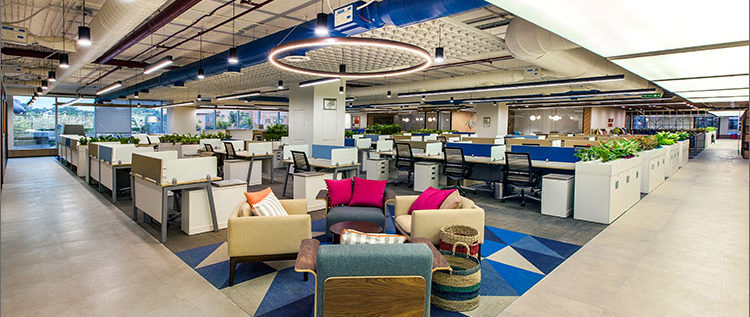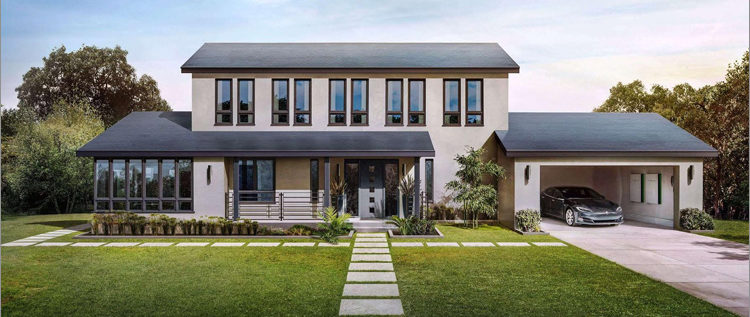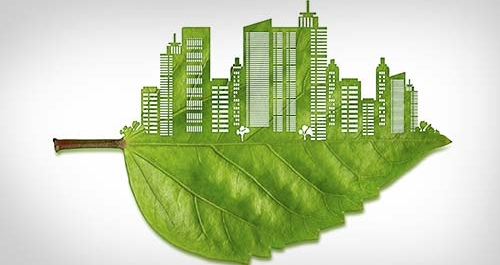CRISIL House, Mumbai
Designed by architect Hafeez Contractor and built by Hiranandani Constructions, CRISIL House is a Platinum-rated LEED certified commercial building which spreads over 211,610 square feet. It is a state-of-the-art “green” building, designed to optimise consumption of scarce water and energy resources. The building’s features reduce energy consumption by 40% and water consumption by 30%.
[caption id="attachment_28736" align="alignnone" width="300"] CRISIL House, Mumbai[/caption]
CRISIL House, Mumbai[/caption]
Completed in 2010, it comprises 14 gardens inside the building, rooftop solar panels, treated fresh air units, sewage treatment plant and RO water system.The interiors are constructed with recycled materials like glass that allow maximum natural daylight in the building thus reducing energy consumption. About 70 per cent of the work area does not require artificial lighting during daytime.
ITC Royal Gardenia, Bengaluru
ITC Royal Gardenia in Bengaluru is the largest hotel in the world to achieve LEED Platinum rating. It is a joint effort by Delhi-based architecture firm Rajinder Kumar & Associates, energy and sustainability consultants Environmental Design Solutions (EDS) and London-based Interior designer Francesca Basu. [caption id="attachment_28740" align="alignnone" width="300"] ITC Royal Gardenia, Bengaluru[/caption]
The lobby green design includes green vertical walls and sustainably-made furnishings. Fly-ash bricks, double-sandwiched cladding glass, huge roof gardens and the use of eco-friendly piping amplify the projects green features. The hotel overall energy savings of 42%, as compared to other hotels of its size is achieved through. LED lights and natural daylighting pockets. Thelow-flow fixtures in bathrooms, use of Forest Stewardship Council (FSC) certified wood, and a water usage standard 33% lower than the LEED Platinum baseline are some of its sustainability achievements.
Guwahati Neurological Research Centre (GNRC), Assam
GNRC, founded in 1987 by Nomal Chandra Borah, is the first green hospital in North East India. The bamboo cladding was used in the construction of building’s exterior. This bamboo cladding acts as a natural insulator and allows the hospital to do away with the air-conditioning in lobbies and reception, thus resulting in saving electricity and reducing maintenance cost.
[caption id="attachment_28737" align="alignnone" width="300"]
ITC Royal Gardenia, Bengaluru[/caption]
The lobby green design includes green vertical walls and sustainably-made furnishings. Fly-ash bricks, double-sandwiched cladding glass, huge roof gardens and the use of eco-friendly piping amplify the projects green features. The hotel overall energy savings of 42%, as compared to other hotels of its size is achieved through. LED lights and natural daylighting pockets. Thelow-flow fixtures in bathrooms, use of Forest Stewardship Council (FSC) certified wood, and a water usage standard 33% lower than the LEED Platinum baseline are some of its sustainability achievements.
Guwahati Neurological Research Centre (GNRC), Assam
GNRC, founded in 1987 by Nomal Chandra Borah, is the first green hospital in North East India. The bamboo cladding was used in the construction of building’s exterior. This bamboo cladding acts as a natural insulator and allows the hospital to do away with the air-conditioning in lobbies and reception, thus resulting in saving electricity and reducing maintenance cost.
[caption id="attachment_28737" align="alignnone" width="300"] Guwahati Neurological Research Centre (GNRC), Assam[/caption]
The building incorporates green features like effective water management by using efficient irrigation systems and STPs. It also uses Low-flow plumbing fixtures. T5 & CFL lightings throughout the hospital save significant energy annually.Efficient HVAC results in huge energy savings and comfort. Solar Street Lamps have also been installed in GNRC to reduce external lighting energy consumption.Low Emitting Materials- Paints, Sealants & adhesives been used.
Guwahati Neurological Research Centre (GNRC), Assam[/caption]
The building incorporates green features like effective water management by using efficient irrigation systems and STPs. It also uses Low-flow plumbing fixtures. T5 & CFL lightings throughout the hospital save significant energy annually.Efficient HVAC results in huge energy savings and comfort. Solar Street Lamps have also been installed in GNRC to reduce external lighting energy consumption.Low Emitting Materials- Paints, Sealants & adhesives been used.
Oberoi Mall, Mumbai
In 2014, the Oberoi Mall in Mumbai by Oberoi Realty became the first in India & the third in the world to receive the LEED Gold certification for best sustained performance of buildings with respect to green features that too in its 6th year of operation. [caption id="attachment_28741" align="alignnone" width="300"] Oberoi Mall, Mumbai[/caption]
The establishment engaged environmentally preferred practices like use of Green Seal Certified chemicals for cleaning activities, rain water harvesting pits, STP, 100% parking under cover, using Dual Flush WC, sensor based urinals, aerator fitted faucets and water sub-meters For energy saving, CFL lamps, LED, Lux Level sensors, Occupancy sensors, Hydro pneumatic pumps, sky-ighting, air-cooled screw chillers, VFD for elevators, escalators, Automatic PF control and building management system for operating the building were used environment friendly R-134 refrigerant for HVAC and commercial refrigerators. The mall AC system fresh air quantity too exceeds requirement of ASHRAE by 30%.
T- ZED Homes, Bengaluru
Biodiversity Conservation India Limited (BCIL), TZed Homes is the first residential apartment project anywhere in the world to be rated Platinum, post-construction. A 2, 49, 000-sft project on a 5.5 acre, it is designed to achieve a near-zero carbon footprint.
[caption id="attachment_28734" align="alignnone" width="300"]
Oberoi Mall, Mumbai[/caption]
The establishment engaged environmentally preferred practices like use of Green Seal Certified chemicals for cleaning activities, rain water harvesting pits, STP, 100% parking under cover, using Dual Flush WC, sensor based urinals, aerator fitted faucets and water sub-meters For energy saving, CFL lamps, LED, Lux Level sensors, Occupancy sensors, Hydro pneumatic pumps, sky-ighting, air-cooled screw chillers, VFD for elevators, escalators, Automatic PF control and building management system for operating the building were used environment friendly R-134 refrigerant for HVAC and commercial refrigerators. The mall AC system fresh air quantity too exceeds requirement of ASHRAE by 30%.
T- ZED Homes, Bengaluru
Biodiversity Conservation India Limited (BCIL), TZed Homes is the first residential apartment project anywhere in the world to be rated Platinum, post-construction. A 2, 49, 000-sft project on a 5.5 acre, it is designed to achieve a near-zero carbon footprint.
[caption id="attachment_28734" align="alignnone" width="300"] T- ZED Homes, Bengaluru[/caption]
The homes are provided with CFLs, HFC-HCFC free air-conditioning system and the gensets powered on bio-diesel. The soil stabilized blocks that naturally cool the home are used for the exterior walls and the roof planes. The foundation and framed structure utilized insulated concrete forms that saved over 26% in the concrete and steel. The TZed campus is self-sustaining and manages without municipal water supply and a sewerage board connection. The 91 apartments and townhouse units incorporate solar-based ventilators and storm-water recycling for irrigation. Combined with occupancy sensors, and abundant daylight in homes, the project has reduced water consumption by 50% and energy use by 70%.
T- ZED Homes, Bengaluru[/caption]
The homes are provided with CFLs, HFC-HCFC free air-conditioning system and the gensets powered on bio-diesel. The soil stabilized blocks that naturally cool the home are used for the exterior walls and the roof planes. The foundation and framed structure utilized insulated concrete forms that saved over 26% in the concrete and steel. The TZed campus is self-sustaining and manages without municipal water supply and a sewerage board connection. The 91 apartments and townhouse units incorporate solar-based ventilators and storm-water recycling for irrigation. Combined with occupancy sensors, and abundant daylight in homes, the project has reduced water consumption by 50% and energy use by 70%.
Indira ParyavaranBhawan, New Delhi
GRIHA 5-Star and LEED India Platinum rated Indira Paryavaran Bhawan in New Delhi is a project of Ministry of Environment and Forests proclaimed as India's first net zero energy building. The building is constructed with fly ash bricks, recycled contents, local building materials, high reflecting roof tiles, rock wool insulation for outer walls and mix of bamboo and jute material composite for door frames.
[caption id="attachment_28738" align="alignnone" width="300"] Indira Paryavaran Bhawan, New Delhi[/caption]
Indira Paryavaran Bhawan, New Delhi[/caption]



















